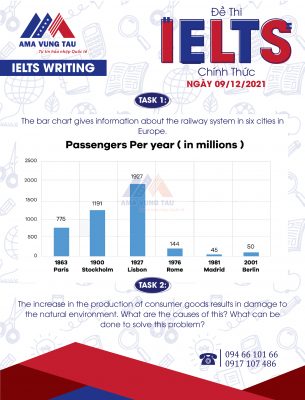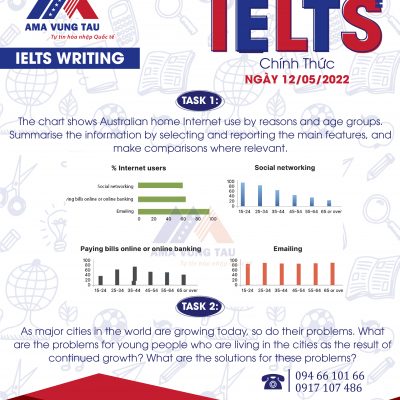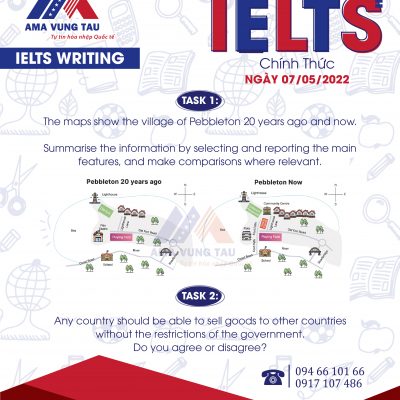Task 1
Đề bài
| The bar chart gives information about the railway system in six cities in Europe. |
Sample
Six railways in six European cities are depicted in the diagrams regarding the transporting capacities.
Overall, it could be seen that despite being relatively aged, Lisbon’s system has the most railway commuters while the more modern systems are quite inferior to that.
To begin with, the Lisbon railway station sees approximately 2 billion travellers each year. This overwhelming figure makes it the busiest train station amongst all the six given ones. Following in the second position is Stockholm railway, which was built in the year 1900 is home to over half of the first described figure; nevertheless, Paris, despite having the world’s oldest ( being built in the 19th century), only serves 775 million people annually.
Moving to a more recent group, there are some noticeable features. With 144 million passengers every year, Rome’s railway system, which was constructed in 1976 and 50 years younger than the system of Lisbon, serves nearly three times as many people as Madrid’s. Lastly, Berlin’s system is the only one that was built in the 21st century, only having a capacity of 50 million commuters a year, being the second lowest position.
- Relatively aged (adj): tương đối lâu đời
- Inferior (adj): thấp hơn đáng kể
- Capacity (n): sức chứa
Phân tích
Nhìn chung, mặc dù tàu ở Lisbon có lịch sử khá lâu đời nhưng lại có số lượng hành khách cao nhất trong biểu đồ trong khi các tàu mới hơn thì có ít lượt khách hơn hẳn.
Đoạn body đầu tiên tác giả phân tích các tàu lâu đời: Lisbon có lượng khách cao nhất; Sau đó đến Stockholm và Paris dù có từ lâu nhưng lượt khách chỉ đứng thứ 3. Đoạn body tiếp theo so sánh các ga tàu gần đây hơn bằng cách lần lượt nêu số lượng hành khách. Tuy nhiên để tránh sự rời rạc cho bài thì nên tạo sự liên kết giữa chúng (three times as many people) hoặc thay đổi cấu trúc câu: ‘with 144 million passengers’, ‘having a capacity of 50 million commuters’,…
Task 2
Đề bài
| The increase in the production of consumer goods results in damage to the natural environment. What are the causes of this? What can be done to solve this problem? |
Sample
In contemporary society, more environmental damage is being done to the environment as more consumer items are created. During the course of this essay, I would present possible reasons leading to this situation as well as to propose feasible measures to tackle the issue.
First and foremost, increased consumer product production hurts the environment in two ways: chemical waste from the manufacturing process and mass production of disposable items. More harmful wastes and pollutants are discharged into the environment as more things are created. Many marine and terrestrial creatures have died as a result of compromised water supplies and badly polluted air. In addition, more single-use items, the majority of which are non-biodegradable, are developed to meet customers’ ever-increasing needs. Although these items have a short lifespan, they can linger as garbage for thousands of years, converting our world into a massive landfill and presenting a threat to all living environments.
With the situation mentioned above, actions must be made as soon as feasible to reduce the negative environmental effects of expanding consumer goods consumption. To begin, businesses should promote the use of environmentally friendly materials. Many major coffee shop chains, for example, have lately replaced plastic straws with reusable equivalents made of materials such as paper or bamboo. Furthermore, several governments are pushing the development of more environmentally friendly industrial practices. Many regions around the globe, for example, provide tax advantages and incentives to businesses that use renewable energy, and some enterprises are even permitted to buy green energy at lower costs than traditional fossil fuels.
Finally, there are two major reasons why the increased production of consumer products has a negative influence on the environment. To overcome this issue, governments and businesses must work together to make manufacturing lines more environmentally friendly by using greener materials.
- Contemporary society (n): xã hội ngày nay
- Disposable items (n): sản phẩm dùng 1 lần
- Marine (adj): dưới nước
- Terrestrial (animal): động vật sống trên cạn
- Non-biodegradable (adj): không thể phân huỷ sinh học
- Equivalents (n): sản phẩm thay thế tương đương
Phân tích
Mở bài gián tiếp, mở đầu bằng nhận định chung về tính nghiêm trọng của vấn đề ô nhiễm môi trường; Đồng thời nêu rõ mục đích bài viết sẽ trình bày những hạng mục nào.
Thân bài chia làm 2 đoạn thể hiện 2 mục đích chính: Đoạn 1 nêu nguyên nhân dẫn đến vấn đề (không xử lý rác triệt để dẫn đến ô nhiễm nguồn nước, không khí; Sản xuất hàng loạt những vật dụng khó phân huỷ); Đoạn 2 đưa ra giải pháp tương ứng với những vấn đề vừa đưa ra. Mỗi khi chuyển sang luận điểm mới/ đoạn mới cần có cụm từ chỉ dẫn để dẫn dắt người đọc (First and foremost, to begin, furthermore, for example, finally,…) và đưa ra ví dụ cụ thể để tăng tính thuyết phục cho bài viết.
Kết bài không nêu thêm ý mới, chỉ tổng hợp những ý đã trình bày ở trên bằng những cách diễn đạt khác để tránh lặp từ.
Trên đây là bài giải chi tiết đề Writing ngày 09/12/2021 và những phân tích cụ thể về bài giải. Hy vọng những chia sẻ trên sẽ giúp bạn note thêm được những cấu trúc ấn tượng cho bài thi của mình. Nếu bạn có thắc mắc về bài viết, hãy để lại bình luận bên dưới để được giải đáp nhé!









































